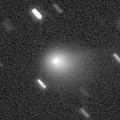
|
It brightened up to 9.0 mag in 2012 autumn (Nov. 4, Juan Jose Gonzalez). It is not observable now. In the Southern Hemisphere, it will appear in the morning sky at 9 mag in 2013 February, then it keeps observable in good condition while fading slowly. In the Northern Hemisphere, it is hardly observable after 2013.
Date(TT) R.A. (2000) Decl. Delta r Elong. m1 Best Time(A, h)
Nov. 17 16 34.48 -13 2.9 2.862 1.935 16 9.4 20:24 ( 65,-11)
Nov. 24 16 48.52 -15 35.5 2.858 1.907 12 9.4 20:33 ( 59,-14)
|
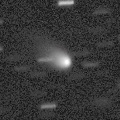
|
It is expected to be a great comet of -1 mag in 2013 spring. It brightened up to 10.1 mag in 2012 autumn (Oct. 14, Marco Goiato). It brightened faster than originally expected. It is not observable now. In the Southern Hemisphere, it will appear in the morning low sky at 8 mag in late December. In the Northern Hemisphere, it keeps unobservable for a long time until 2013 March, when the comet will appear as a 0-mag great comet.
Date(TT) R.A. (2000) Decl. Delta r Elong. m1 Best Time(A, h)
Nov. 17 15 55.92 -31 51.1 3.257 2.311 14 10.2 20:24 ( 45, -5)
Nov. 24 16 5.36 -32 48.2 3.160 2.205 12 9.9 20:33 ( 40, -8)
|
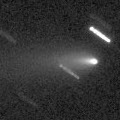
|
Now it is bright at 10.1 mag (Nov. 12, Juan Jose Gonzalez). It is expected to approach to the earth and to be observable at 8 mag in good condition in winter. The condition is good in the Northern Hemisphere. It turns to be in the morning sky after November, and will be getting higher rapidly. In the Southern Hemisphere, it is not observable now. But it will become observable in good condition after 2013 January.
Date(TT) R.A. (2000) Decl. Delta r Elong. m1 Best Time(A, h)
Nov. 17 14 19.51 42 17.2 1.189 1.157 63 10.7 3:06 (240,-38)
Nov. 24 14 13.08 43 37.8 1.040 1.144 68 10.3 3:00 (237,-33)
|
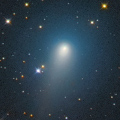
|
It brightened very rapidly. Now it is very bright visually as 10.5 mag (Nov. 12, Juan Jose Gonzalez). It keeps high for a long time in the Northern Hemisphere. But the comet will be fading after this. It locates very low in the Southern Hemisphere. The nuclear split was observed in late October.
Date(TT) R.A. (2000) Decl. Delta r Elong. m1 Best Time(A, h)
Nov. 17 23 46.18 39 30.7 0.680 1.506 127 11.6 20:24 (175, 15)
Nov. 24 23 53.80 40 30.2 0.739 1.534 124 12.3 20:33 (169, 13)
|

|
Now it is bright as 11.4 mag (Oct. 15, Chris Wyatt). It is expected to be observable at 11-13 mag for a long time from 2012 summer to 2013 summer. It is not observable until January in the Northern Hemisphere. In the Southern Hemisphere, it will be extremely low from October to December.
Date(TT) R.A. (2000) Decl. Delta r Elong. m1 Best Time(A, h)
Nov. 17 15 18.05 -42 8.9 2.978 2.107 23 12.1 3:06 (324, 1)
Nov. 24 15 26.75 -40 43.2 3.011 2.122 21 12.2 3:00 (321, 2)
|
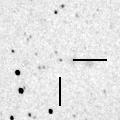
|
Getting brighter much faster than expected. Now it is so bright as 11.8 mag (Nov. 14, V. Gerke, A. Novichonok, S. Plaksa). It must be visible visually. It will approach to the sun down to 0.73 A.U. in 2013 March. It may brighten up to 3 mag at best. In the Southern Hemisphere, it keeps observable while brightening gradually after this in good condition. In the Northern Hemisphere, it is only observable until early January when it becomes 9 mag. After 2013 May, it keeps observable in good condition while fading gradually.
Date(TT) R.A. (2000) Decl. Delta r Elong. m1 Best Time(A, h)
Nov. 17 11 29.22 -9 43.8 2.626 2.277 58 13.0 3:06 (266, 22)
Nov. 24 11 35.36 -12 26.9 2.439 2.183 63 12.5 3:00 (267, 27)
|
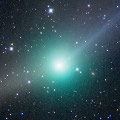
|
It kept as bright as 6-7 mag for a long time from 2011 summer to 2012 spring. Now it is fading. But it is very bright as 12.8 mag still now (Oct. 20, Katsumi Yoshimoto).
Date(TT) R.A. (2000) Decl. Delta r Elong. m1 Best Time(A, h)
Nov. 17 10 5.55 -4 42.8 4.293 4.236 80 12.9 3:06 (248, 36)
Nov. 24 10 3.28 -5 40.6 4.238 4.302 87 13.0 3:00 (243, 41)
|

|
It brightened up to 11-12 mag in 2012. Now it is not observable. But it will be observable at 12-13 mag in good condition again in 2013.
Date(TT) R.A. (2000) Decl. Delta r Elong. m1 Best Time(A, h)
Nov. 17 15 26.30 -15 39.1 6.369 5.383 3 13.4 3:06 (307,-20)
Nov. 24 15 28.01 -15 54.3 6.372 5.399 8 13.4 3:00 (304,-16)
|
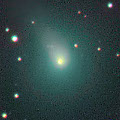
|
It brightened much faster than expected, and reached up to 10.0 mag in summer (Aug. 9, Juan Jose Gonzalez). Now it is fading, but it is bright as 13.0 ma still now (Nov. 15, Sandor Szabo). In the Northern Hemisphere, it keeps observable at 13 mag in good condition until early 2013. In the Southern Hemisphere, it is not observable until late 2012.
Date(TT) R.A. (2000) Decl. Delta r Elong. m1 Best Time(A, h)
Nov. 17 9 53.82 26 9.1 2.282 2.537 93 13.6 3:06 (222, 15)
Nov. 24 9 46.04 24 49.3 2.197 2.580 101 13.6 3:00 (217, 20)
|
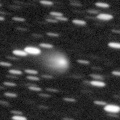
|
Now it is 13.3 mag (Nov. 15, Sandor Szabo). It keeps bright at 13-14 mag for a long time until 2014. It keeps observable for a long time in the Northern Hemisphere. It is not observable in the Southern Hemisphere.
Date(TT) R.A. (2000) Decl. Delta r Elong. m1 Best Time(A, h)
Nov. 17 20 38.54 39 14.0 5.919 6.042 92 13.6 20:24 (142, 1)
Nov. 24 20 38.67 37 50.7 5.990 6.032 87 13.6 20:33 (135, -3)
|
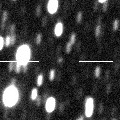
|
First return of a new periodic comet discovered in 1994. Although it had been much fainter than expected, it is brightening rapidly now. Now it is bright as 13.2 mag and visible visually (Nov. 12, Juan Jose Gonzalez). It will be observable at 13 mag in excellent condition from autumn to winter.
Date(TT) R.A. (2000) Decl. Delta r Elong. m1 Best Time(A, h)
Nov. 17 21 26.05 4 12.8 0.840 1.302 90 13.8 20:24 (127, 35)
Nov. 24 21 52.99 1 32.8 0.844 1.288 89 13.8 20:33 (122, 35)
|
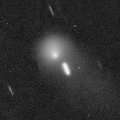
|
Now it is bright as 13.3 mag (Oct. 19, Jakub Cerny). It keeps bright as 13-14 mag for a long time after this until 2013. It is not observable in the Northern Hemisphere, but it is observable in good condition in the Southern Hemisphere.
Date(TT) R.A. (2000) Decl. Delta r Elong. m1 Best Time(A, h)
Nov. 17 3 50.04 -56 52.9 5.622 5.939 104 13.9 0:06 ( 0, 68)
Nov. 24 3 40.82 -56 14.1 5.657 5.959 103 14.0 23:24 ( 0, 69)
|

|
Now it is bright and visible visually at 12.2 mag (Nov. 16, Marco Goiato). It keeps 12-14 mag until February. It keeps observable in good condition in the Northern Hemisphere. In the Southern Hemisphere, it will be getting lower gradually after this, and will be unobservable in late January.
Date(TT) R.A. (2000) Decl. Delta r Elong. m1 Best Time(A, h)
Nov. 17 23 46.51 27 26.2 2.455 3.165 128 14.0 20:24 (174, 27)
Nov. 24 23 50.59 25 55.6 2.512 3.161 123 14.0 20:33 (165, 28)
|

|
It brightened rapidly, and reached up to 12 mag in 2012. It is not observable now. But it will be observable at 12-14 mag in good condition again in 2013. However, it locates somewhat low in the Northern Hemisphere in 2013.
Date(TT) R.A. (2000) Decl. Delta r Elong. m1 Best Time(A, h)
Nov. 17 15 47.07 -15 44.0 3.890 2.906 5 14.0 20:24 ( 55,-18)
Nov. 24 15 58.74 -16 39.0 3.886 2.901 3 14.0 3:00 (310,-21)
|
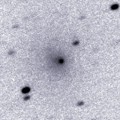
|
Appearing in the morning sky in late November.
Date(TT) R.A. (2000) Decl. Delta r Elong. m1 Best Time(A, h)
Nov. 17 13 33.99 -18 13.2 7.102 6.242 27 14.2 3:06 (291, 2)
Nov. 24 13 38.72 -18 45.0 7.045 6.241 33 14.2 3:00 (289, 5)
|
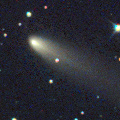
|
First return of a new periodic comet which brightened up to 14 mag in 2005. It brightened very rapidly and became much brighter than originally expected. It is bright as 12.9 mag still now (Nov. 15, Uwe Pilz). It keeps high for a long time in the Northern Hemisphere. But the comet will be fading after this. It locates very low in the Southern Hemisphere.
Date(TT) R.A. (2000) Decl. Delta r Elong. m1 Best Time(A, h)
Nov. 17 1 30.28 42 39.1 0.740 1.652 145 14.3 21:43 (180, 12)
Nov. 24 1 31.02 42 22.3 0.792 1.684 142 14.7 21:16 (180, 13)
|

|
Big asteroid discovered in 1906. It suddenly showed the cometary activity on Dec. 11, 2010, probably due to an impact of a small object. Now it is 11.9 mag (May 29, Marco Goiato). It has already turned to be stellar.
Date(TT) R.A. (2000) Decl. Delta r Elong. m1 Best Time(A, h)
Nov. 17 18 40.74 -31 24.6 3.180 2.570 44 14.3 20:24 ( 67, 23)
Nov. 24 18 54.78 -31 15.9 3.247 2.579 40 14.3 20:33 ( 64, 19)
|
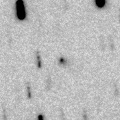
|
Now it is visible visually at 14.7 mag (Nov. 15, Sandor Szabo). It is expected to brighten up to 10 mag from winter to spring in 2013. In the Northern Hemisphere, it keeps observable in good condition until 2013 April. It is not observable now in the Southern Hemisphere. It will become observable after 2013 April, but it keeps locating low.
Date(TT) R.A. (2000) Decl. Delta r Elong. m1 Best Time(A, h)
Nov. 17 20 6.75 81 34.5 2.279 2.720 105 14.6 20:24 (171,-31)
Nov. 24 20 46.46 80 11.8 2.186 2.652 107 14.4 20:33 (170,-30)
|
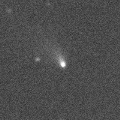
|
Now it is visible visually at 15.0 mag (Nov. 15, Sandor Szabo). It keeps 15 mag until March. In the Northern Hemisphere, it keeps observable for a long time until the comet fades out. It is not observable in the Southern Hemisphere, except for 2013 spring, but the comet locates extremely low only.
Date(TT) R.A. (2000) Decl. Delta r Elong. m1 Best Time(A, h)
Nov. 17 13 55.95 73 0.6 2.025 2.305 93 15.2 3:06 (201,-38)
Nov. 24 13 58.60 75 33.5 1.935 2.291 97 15.0 3:00 (198,-37)
|
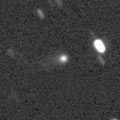
|
Now it is visible visually at 14.4 mag (Nov. 15, Sandor Szabo). It keeps 15-16 mag until February. It keeps observable in good condition for a long time until the comet fades out in the Northern Hemisphere. It is not observable until 2013 summer in the Southern Hemisphere. By the way, Juan Jose Gonzalez reported it extremely bright as 10.4 mag visually on Nov. 6.
Date(TT) R.A. (2000) Decl. Delta r Elong. m1 Best Time(A, h)
Nov. 17 9 0.61 86 54.5 3.086 3.539 109 15.5 3:06 (182,-32)
Nov. 24 2 54.52 88 2.7 3.046 3.542 112 15.5 22:18 (180,-33)
|
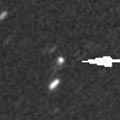
|
It is expected to keep 13 mag and observable in good condition in the Northern Hemisphere for a long time from 2013 to 2014. Now it is 15.8 mag (Oct. 19, Hiroshi Abe). It will be observable also in the Southern Hemisphere from early December to early March, although it locates low.
Date(TT) R.A. (2000) Decl. Delta r Elong. m1 Best Time(A, h)
Nov. 17 11 28.40 18 50.5 5.227 4.981 70 15.6 3:06 (243, 5)
Nov. 24 11 30.42 19 38.8 5.065 4.939 77 15.5 3:00 (239, 8)
|
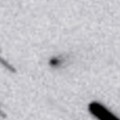
|
Brightening very rapidly. Now it is 15.1 mag (Nov. 15, Catalina Sky Survey). It approaches to the Sun down to 0.3 A.U. in 2013 February. The ephemeris says it will brighten up to 7 mag. However, because the comet is small, it may be disintegrated. It keeps observable in good condition until February while brightening gradually.
Date(TT) R.A. (2000) Decl. Delta r Elong. m1 Best Time(A, h)
Nov. 17 3 16.59 9 44.1 1.100 2.081 170 15.9 23:27 (180, 46)
Nov. 24 2 55.30 5 25.0 1.020 1.971 158 15.5 22:38 (180, 50)
|
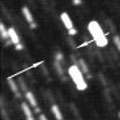
|
Now it is 14.8 mag (Oct. 7, Jakub Cerny). In the Southern Hemisphere, it will be observable at 15-16 mag in good condition for a long time until 2013 summer. It is not observable at all in the Northern Hemisphere.
Date(TT) R.A. (2000) Decl. Delta r Elong. m1 Best Time(A, h)
Nov. 17 19 36.65 -80 26.6 4.255 3.969 66 15.6 20:24 ( 11, 38)
Nov. 24 20 12.67 -80 6.2 4.292 3.982 65 15.7 20:33 ( 12, 38)
|

|
It kept as bright as 11-12 mag for a long time from 2011 autumn to 2012 spring. Now it is fading. It has already faded down to 17.1 mag (Nov. 14, Catalina Sky Survey). It keeps observable in good condition until next spring while the comet will be fading gradually.
Date(TT) R.A. (2000) Decl. Delta r Elong. m1 Best Time(A, h)
Nov. 17 10 24.38 3 38.1 3.088 3.047 78 15.9 3:06 (244, 27)
Nov. 24 10 29.09 3 0.4 3.020 3.080 84 15.9 3:00 (241, 30)
|
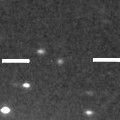
|
Now it is 16.5 mag (Nov. 12, Gerke, A. Novichonok, S. Plaksa). It is expected to be a great comet in 2013 autumn when the comet approaches to the sun down to only 0.01 A.U. It keeps visible with naked eyes from November to January, and can be extremely bright as Venus or more at the highlight. The condition is excellent in the Northern Hemisphere. It keeps observable almost all through the period of brightening, at the highlight, and of fading. The condition is not good in the Southern Hemisphere. It is not observable at all the latter part of the highlight, and it keeps low all through the period.
Date(TT) R.A. (2000) Decl. Delta r Elong. m1 Best Time(A, h)
Nov. 17 8 19.55 28 35.6 5.254 5.728 114 16.7 3:06 (201, 23)
Nov. 24 8 17.44 28 51.9 5.078 5.657 121 16.6 3:00 (196, 24)
|

|
Now it is 18.4 mag (Nov. 13, R. Naves, M. Campas). It will brighten very rapidly, and reach up to 13 mag from winter to spring. In the Northern Hemisphere, it keeps observable in excellent condition. In the Southern Hemisphere, it keeps locating extremely low for a while.
Date(TT) R.A. (2000) Decl. Delta r Elong. m1 Best Time(A, h)
Nov. 17 9 42.77 36 57.0 2.038 2.398 98 16.9 3:06 (213, 8)
Nov. 24 9 52.93 36 46.4 1.929 2.361 103 16.6 3:00 (212, 9)
|

|
Now it is 17.0 mag (Nov. 12, Yasukazu Ikari). It will brighten up to 12 mag from summer to autumn in 2013. In the Northern Hemisphere, it is observable only until 2013 spring when the comet brightens up to 15 mag. In the Southern Hemisphere, it keeps unobservable until 2013 August. Then it keeps observable while fading gradually.
Date(TT) R.A. (2000) Decl. Delta r Elong. m1 Best Time(A, h)
Nov. 17 21 28.93 68 53.6 3.289 3.709 107 17.3 20:24 (166,-18)
Nov. 24 21 36.96 67 19.5 3.230 3.640 106 17.2 20:33 (162,-18)
|
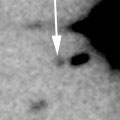
|
Now it is 17.3 mag (Nov. 10, K. Hills). In the Southern Hemisphere, it keeps observable at 17 mag in good condition for a long time from 2012 to 2013. It is not observable at all in the Northern Hemisphere.
Date(TT) R.A. (2000) Decl. Delta r Elong. m1 Best Time(A, h)
Nov. 17 6 20.29 -72 25.0 4.876 4.878 84 17.3 2:36 ( 0, 53)
Nov. 24 5 57.83 -73 59.6 4.883 4.871 83 17.3 1:46 ( 0, 51)
|
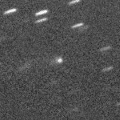
|
Now it is 17.3 mag (Nov. 11, H. Denzau). It keeps 17 mag for a long time from 2009 to 2013.
Date(TT) R.A. (2000) Decl. Delta r Elong. m1 Best Time(A, h)
Nov. 17 22 14.52 7 11.0 8.354 8.627 102 17.5 20:24 (141, 40)
Nov. 24 22 12.99 6 48.3 8.491 8.643 95 17.5 20:33 (131, 34)
|
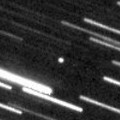
|
Now it is 17.4 mag (Sept. 29, Jean-Francois Soulier). In the Northern Hemisphere, it will be observable at 17.5 mag in excellent condition in October and November. It locates low in the Southern Hemisphere.
Date(TT) R.A. (2000) Decl. Delta r Elong. m1 Best Time(A, h)
Nov. 17 1 31.67 36 56.1 1.409 2.311 148 17.6 21:43 (180, 18)
Nov. 24 1 19.58 34 30.7 1.470 2.330 142 17.8 21:04 (180, 21)
|
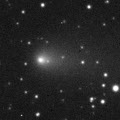
|
It brightened up to 12 mag in 2010. Now the comet is around the aphelion. But it will be observable at 17.5 mag in good condition from autumn to winter. However, now it is 19.2 mag (Nov. 12, Gerke, A. Novichonok, S. Plaksa), much fainter than this ephemeris.
Date(TT) R.A. (2000) Decl. Delta r Elong. m1 Best Time(A, h)
Nov. 17 4 23.94 20 56.9 3.676 4.645 167 17.6 0:40 (180, 34)
Nov. 24 4 18.93 20 53.2 3.669 4.653 175 17.6 0:08 (180, 34)
|
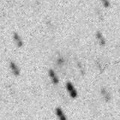
|
Now it is 17.4 mag (Oct. 19, H. Denzau). Because it is a very distant object, it keeps 18 mag for a long time until 2014.
Date(TT) R.A. (2000) Decl. Delta r Elong. m1 Best Time(A, h)
Nov. 17 22 5.36 10 8.4 9.320 9.567 101 17.7 20:24 (141, 36)
Nov. 24 22 6.53 9 46.4 9.433 9.571 95 17.7 20:33 (132, 31)
|
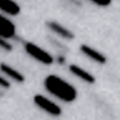
|
Now it is 17.5 mag (Nov. 10, J. Lozano). It keeps 17-18 mag for a long time until the end of 2013. The condition is good in the Northern Hemisphere. It is hardly observable in 2012 in the Northern Hemisphere. But it will be observable in good condition in 2013.
Date(TT) R.A. (2000) Decl. Delta r Elong. m1 Best Time(A, h)
Nov. 17 23 35.82 46 58.8 4.079 4.717 125 17.8 20:24 (174, 8)
Nov. 24 23 31.02 44 35.5 4.118 4.696 120 17.8 20:33 (166, 9)
|
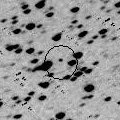
|
Peculiar asteroid moving along a cometary orbit. It keeps observable at 18 mag for a long time from 2008 to 2014. It locates extremely low in the Southern Hemisphere.
Date(TT) R.A. (2000) Decl. Delta r Elong. m1 Best Time(A, h)
Nov. 17 8 5.58 34 5.8 6.539 7.053 117 17.8 3:06 (196, 19)
Nov. 24 8 2.89 34 53.5 6.451 7.064 125 17.8 3:00 (191, 19)
|
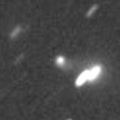
|
Jakub Cerny reported the comet brightened up to 14.5 mag in late July. It is bright as 15.7 mag still now (Oct. 19, Jakub Cerny). It will be observable in good condition in the Southern Hemisphere while fading gradually after this. It will locate somewhat low in the Northern Hemisphere.
Date(TT) R.A. (2000) Decl. Delta r Elong. m1 Best Time(A, h)
Nov. 17 22 50.16 -28 19.6 3.993 4.237 97 17.9 20:24 (106, 71)
Nov. 24 22 53.16 -27 47.4 4.148 4.292 91 18.1 20:33 ( 99, 64)
|
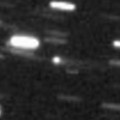
|
It reached up to 17 mag in last winter between 2011 and 2012. It will be observable in good condition again at 17.5 mag in this winter.
Date(TT) R.A. (2000) Decl. Delta r Elong. m1 Best Time(A, h)
Nov. 17 9 38.17 15 55.9 3.906 4.084 93 18.0 3:06 (225, 25)
Nov. 24 9 40.83 15 44.0 3.808 4.091 99 17.9 3:00 (221, 28)
|

|
First return of a new periodic comet discovered in 1997 at 17 mag. Now it is 18.1 mag (Nov. 14, R. Ligustri). It was expected to keep 17 mag for a long time from 2012 to 2014. But actually, it is fainter than predicted by 1-2 mag.
Date(TT) R.A. (2000) Decl. Delta r Elong. m1 Best Time(A, h)
Nov. 17 1 57.37 12 32.6 2.949 3.877 156 19.1 22:09 (180, 42)
Nov. 24 1 54.62 12 12.8 2.982 3.862 149 19.1 21:39 (180, 43)
|
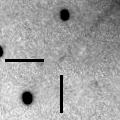
|
It was observed at 17 mag in 2011 autumn. It was expected to be observable at 17 mag in good condition again from autumn to winter in 2012. But actually, the comet is 19.4 mag (Sept. 29, G. Hug), much fainter than this ephemeris. Hidetaka Sato reported that it was not detected, fainter than 21.0 mag (Sept. 21). The comet must have faded out very rapidly.
Date(TT) R.A. (2000) Decl. Delta r Elong. m1 Best Time(A, h)
Nov. 17 6 47.83 31 57.4 2.355 3.123 133 20.4 3:03 (180, 23)
Nov. 24 6 44.80 33 24.0 2.313 3.144 141 20.4 2:33 (180, 22)
|
|
![]()
 C/2012 V2 ( LINEAR )
C/2012 V2 ( LINEAR ) C/2012 C1 ( McNaught )
C/2012 C1 ( McNaught ) C/2008 S3 ( Boattini )
C/2008 S3 ( Boattini ) (3200) Phaethon
(3200) Phaethon 65P/Gunn
65P/Gunn C/2012 Q1 ( Kowalski )
C/2012 Q1 ( Kowalski ) C/2012 S4 ( PanSTARRS )
C/2012 S4 ( PanSTARRS ) 2008 YB3
2008 YB3 C/2011 A3 ( Gibbs )
C/2011 A3 ( Gibbs ) 244P/2010 Q1 ( Scotti )
244P/2010 Q1 ( Scotti ) 270P/2012 S5 ( Gehrels )
270P/2012 S5 ( Gehrels ) P/2011 N1 ( ASH )
P/2011 N1 ( ASH )![]()


































